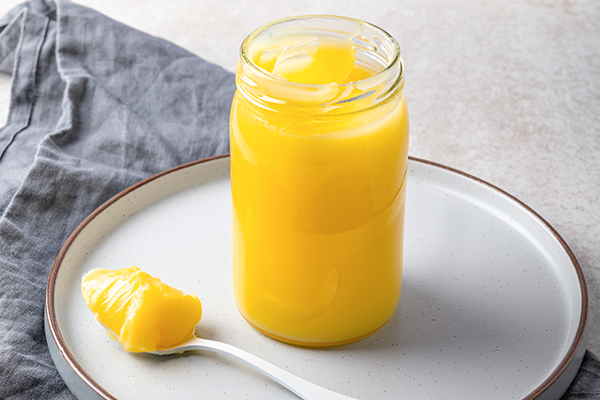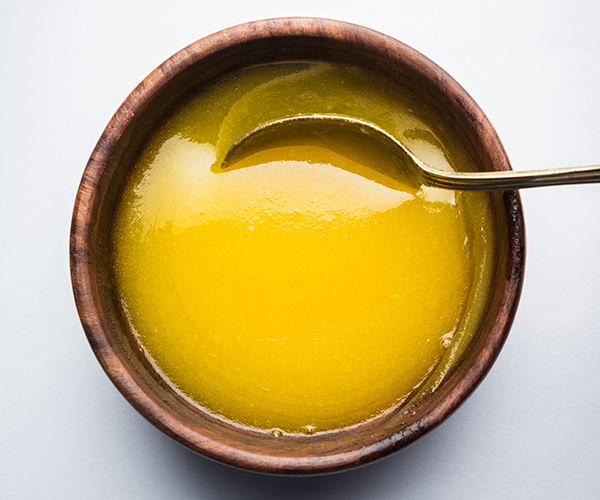[ad_1]
Butter can amp up the flavour in a recipe, however it’s positively a “use carefully” meals.
However ghee, a variation of clarified butter, has been displaying up increasingly in wholesome recipes and on the cabinets of well being meals shops.
Ghee is a longtime staple in Indian cooking, however is it more healthy than butter? Right here’s what it’s essential know.
What Is Ghee?
“Ghee is a kind of clarified butter with origins in India,” explains Lindsey Janeiro, R.D.N., of Vitamin to Match.
Ghee is made by heating and straining butter to take away the milk solids.
It could sound like a tedious additional step, however clarifying butter could also be useful for some folks.
“The clarifying course of separates milk from fats, with the milk solids being eliminated,” explains Kara Lydon, R.D., L.D.N., proprietor of Kara Lydon Vitamin and The Foodie Dietitian Blog.
Due to this course of, ghee is usually lactose-free, Lydon provides.
Which means you might be able to deal with ghee even if in case you have lactose intolerance or sensitivity.
However though “some people with slight dairy sensitivities discover that they will tolerate ghee higher than butter, it’s essential to notice that ghee continues to be a dairy product and never applicable for these with dairy allergy symptoms,” Janeiro cautions.
Ghee can also be sometimes freed from casein, a milk protein that may cause gastrointestinal symptoms in folks with dairy sensitivity and intolerance.
Nonetheless, not all manufacturers of ghee are casein-free, so it’s most likely finest to keep away from ghee if in case you have a casein allergy.
Tips on how to Make Ghee
It’s simple to make your personal ghee at house. Lydon gives these simple steps:
- Minimize 2 sticks of butter into cubes and add to a saucepan over low to medium warmth.
- Let the butter absolutely soften and simmer for 10 minutes.
- When milk solids acquire on the underside of the saucepan and switch a golden shade, take away from warmth.
- Pressure out the milk solids utilizing a mesh colander lined with cheesecloth. (Should you don’t have cheesecloth at house, you should use a single sheet of paper towel as a substitute.)
Your ghee might be a golden liquid whenever you’re carried out making it, however will ultimately cool to a strong.
Although it doesn’t must be refrigerated, it can last more if saved that manner.
Suggestions for making ghee
- Use a pan with a silver backside, if potential — it’ll be simpler to see when the solids are altering shade and hitting that golden hue.
- It’s regular to your butter to foam whilst you’re simmering it. This can ultimately subside.
- After the foaming subsides, you might even see solids floating on the high. You may skim these out throughout the simmering course of with a slotted spoon, or simply pressure all the saucepan of butter on the finish — your alternative.
Tips on how to Use Ghee
So what’s ghee used for? “Ghee has a a lot increased smoke level than butter,” Lydon says, which makes it an ideal alternative when sautéing or frying meals.
Ghee can face up to cooking temperatures up to about 485° F.
The excessive smoke level might provide advantages that transcend taste. Cooking fat can break down once they’re heated to particular temperatures, producing probably dangerous compounds.
However “one study showed that cooking with the next smoke-point fats equivalent to ghee produced fewer dangerous compounds,” Lydon says.
And ghee isn’t only for cooking.
Apply it to toast, baked potatoes, or rice, and chances are you’ll discover that “ghee typically has a richer, nuttier taste than butter,” Lydon provides.
Ghee Vitamin
Although clarifying and straining butter removes the milk solids, Janeiro notes that the “dietary variations between ghee and butter are fairly small.”
One tablespoon of ghee incorporates:
- 123 energy
- 13.9 grams of fats
- 0 grams of protein
By comparability, one tablespoon of unsalted butter incorporates:
- 102 energy
- 11.5 grams of fats
- 0 grams of protein
Ghee additionally incorporates butyrate, “a short-chain fatty acid which may play a role in supporting digestive health,” explains Lydon.
Nonetheless, it’s not one thing it’s best to slather on all the pieces.
Ghee is “nonetheless a saturated fats and may nonetheless be consumed carefully within the context of an general balanced weight loss program,” Janeiro says.
[ad_2]
Source link






